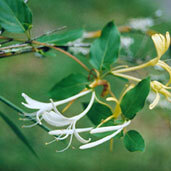Shrubs or woody climbers, rarely small trees or herbs. Leaves opposite, rarely whorled, simple or pinnatifid, conduplicate or involute in vernation; interpetiolar stipules absent or rarely well developed. Inflorescence thyrsoid, axillary or terminal, compact or lax, cymes 1-, 2-, or 3-flowered; paired flowers sometimes with ovaries ± fused. Cymes with a pair of bracts and 2 pairs of bracteoles, located at base of ovaries, ± fused, occasionally accrescent in fruit, rarely absent. Flowers bisexual, actinomorphic or zygomorphic. Calyx 4-or 5-lobed. Corolla epigynous, gamopetalous; lobes 4 or 5, spreading, sometimes bilabiate, aestivation imbricate. Stamens (4 or)5, didynamous, alternating with corolla lobes, sometimes exserted; anthers free, 2-celled, opening by longitudinal slits, introrse. Ovary inferior, carpels 2-8, fused; placenta axile; ovules 1 to many per locule, some of which can be abortive, pendulous; style solitary; stigmas capitate or lobed. Fruit a berry, a drupe with 2-5 pyrenes, or a leathery achene. Seeds 1 to many; embryo small, straight; endosperm copious.
Small trees, shrubs, woody climbers or rarely herbs, often with soft pith. Leaves opposite or less often alternate, simple or pinnately compound; stipules absent or very small, rarely conspicuous. Inflorescences mainly cymose, less often flowers solitary or paired; bracts and bracteoles usually present. Flowers regular or irregular, hermaphrodite. Calyx-tube joined with the ovary; limb (3–)4–5-fid or-toothed, the teeth imbricate or open. Corolla gamopetalous, tubular, funnel-shaped, campanulate or rotate, 3–5-lobed, sometimes 2-lipped, the lobes imbricate or less often valvate. Stamens 4–5, inserted in the corolla-tube and alternate with the lobes; anthers 2-thecous, opening lengthwise inwards or outwards. Ovary inferior, 2–8-locular, with 1-many pendulous ovules in each locule; placentation axile or parietal; style simple or wanting; stigma ], capitate, or stigmas as many as the carpels. Fruit a berry or drupe, less often a capsule or achene, 1–5-locular with 1–many seeds or as many pyrenes as locules; endosperm copious; embryo mostly small and straight

